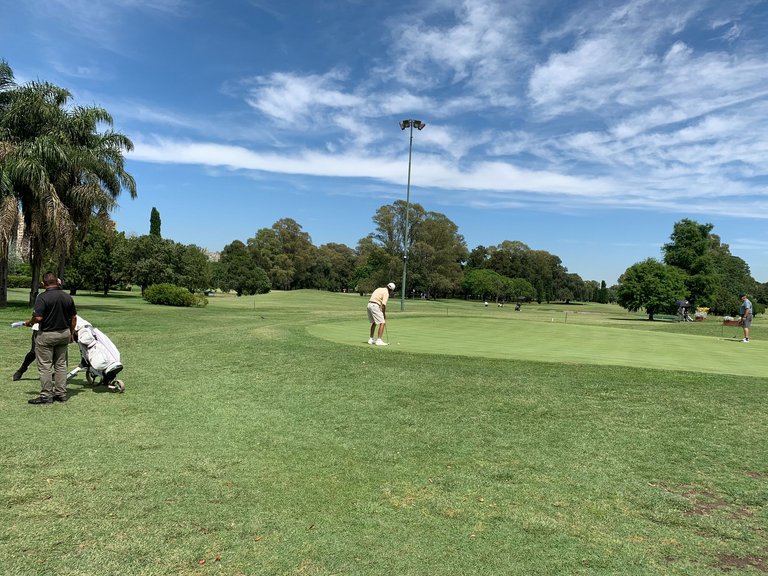Una mirada al golf amateur (V) (SPA-ENG)

Dentro de lo que pretendía con esto de hablar de golf desde la visión de un amateur al que le gusta jugar, tanto como brindar detalles básicos para todo aquel que sienta curiosidad por este deporte y quizás se anime a practicarlo, queda hablar un poco del concepto general del juego y quizás algo de las reglas, que son muchas y en algunos casos de cierta complejidad.
Como todos saben el golf es un deporte donde se deben completar hoyos en la menor cantidad de golpes posible, si están compitiendo contra alguien más, el que menos golpes necesite para completar el circuito preestablecido será el ganador. En caso de jugar contra uno mismo, cosa perfectamente posible en este deporte, tendremos como objetivo superarnos haciendo menos golpes que la vez anterior y si es posible establecer una nueva marca personal, así como en un video juego, por ejemplo.
Un hoyo comienza en el tee de salida y termina en el agujero en el green donde debemos embocar nuestra pelota. Generalmente ese agujero tendrá puesta una bandera y sabremos desde la distancia el lugar donde apuntar. Ahora bien, hablemos de la distancia y también de los golpes establecidos para completar un hoyo.
Los que han visto algún torneo por televisión o recorrido un campo de juego, habrán notado que no todos los hoyos tienen el mismo "par" y mencionamos esa palabra ya que se utiliza regularmente y significa la cantidad de golpes que un profesional o un aficionado de un nivel similar al de un profesional (scratch) deben utilizar para completar el recorrido, así nos encontramos con hoyos de par 3, de par 4 y de par 5, excepcionalmente hay hoyos de par 6 pero en mis años de experiencia y de trajinar por los distintos campos de juego, solo vi dos en los cuales existe un hoyo de par 6.
Los hoyos de par 3 deben ser completados por un profesional o un scratch en 3 golpes, esos hoyos son los que menor distancia poseen entre el tee de salida y la bandera que señala el hoyo propiamente dicho en el green, no existe una distancia preestablecida y cada campo puede diseñar y colocar varios pares 3 en su recorrido, esos hoyos tienen entre 100 y 250 yardas aproximadamente, hay algunos más cortos y excepcionalmente algunos más largos. Continuando con la misma lógica, los hoyos de par 4 deben ser completados cada uno de ellos con 4 golpes para un profesional y/o un scratch y lo mismo ocurre con los pares 5. Los hoyos de par 4 son los más habituales en cualquier campo de juego y tanto los pares 3 como los pares 5 nunca llegan entre ambos a tener la mitad de los hoyos; tampoco aquí hay una regla estipulada, pero es normal que en cualquier campo de juego que tenga los habituales 18 hoyos existan 3 o 4 par 3 y aproximadamente la misma cantidad de par 5. Los hoyos de par 4 tienen entre >250 yardas y hasta 500 yardas mientras que los pares 5 pueden tener entre > 400 y 600 yardas. Como mencioné antes, no hay ninguna disposición que regule una determinada cantidad ni distancia en estos hoyos.

Explicado el tema del par de cada hoyo que componen un campo de juego de 18 hoyos, el par de la cancha estará determinado por la suma del par de cada uno de sus hoyos, es por ello que se habla de campos de juego de par 70 o 71 o quizás 72 golpes excepcionalmente hay algunos campos de juego de par 73.
Recuerden que ese valor es indicativo para lo que se espera de un profesional, pero por supuesto no es una obligación. Entonces si estos jugadores en un par 3 hacen 2 golpes es un birdie lo que significa que hicieron un golpe menos de lo requerido, si completan el hoyo en un golpe más de lo indicado será un bogey, 2 más un doble bogey y así sucesivamente. También hay denominaciones para cuando se hace 2 menos de lo requerido: se denomina águila y si hace 3 menos de lo requerido será un albatros. No existe el albatros para un par 3 por supuesto, solo águila si se tiene la suerte de embocar en un solo golpe a lo cual también se denomina hoyo en 1. Antes de que me pregunten, no, jamás hice un hoyo en un solo golpe, por la distancia que existe desde la salida hasta la bandera, es muy difícil hacer hoyo en uno en un par 4 pero es más habitual en los pares 3. También existe la posibilidad de hacer un albatros en un par 5 para ello es necesario embocar la pelota en solo 2 golpes, pensando que un par 5 tiene cerca de 500 yardas o más, verán la enorme dificultad para lograrlo en tan pocos golpes.
¿Conocen algún deporte donde un aficionado con escasa experiencia y práctica puedan competir de igual a igual con un profesional que dedica horas al día para practicar y perfeccionarse? yo sí, el golf. Este deporte tiene una fórmula que permite igualar las posibilidades de competencia entre jugadores de diferente nivel y categoría, se llama hándicap y a continuación lo explico. El hándicap es un número que se le asigna a todo aficionado cuando se inscribe en alguna federación o club para que se lo administre, no es gratis ni tampoco barato, pero aquellos que quieran competir en torneos deberán inscribirse porque en caso contrario no serán admitidos. Si sus expectativas solo incluyen jugar para divertirse y aprender, competir con amigos informalmente, no hay problema, no tendrán que obtener su matrícula y su hándicap, solo puede ocurrir que algunos clubes de ciertos rasgos costumbristas, no le permitan jugar, no importa, hay muchos otros que lo aceptarán de buen grado siempre que abone el "green fee" que no es otra cosa que el valor designado por cada club para poder hacer uso de sus instalaciones y su campo de juego. A todo jugador que recién se inicia o se inscribe y obtiene su matrícula, se le asigna un hándicap de 25, eso significa que, si ese jugador se inscribe en un torneo y juega contra un profesional, este le dará 25 golpes de ventaja. vamos a un ejemplo: el campo es par 71 y supongamos que el profesional lo recorre anotando 70 golpes (-1) y este otro jugador aficionado necesita 94 golpes, 94 - 25 de su hándicap son 69 (-2), significa que el aficionado ganó por un golpe al profesional. ¿No es maravilloso?
Ahora bien, como se sabe si este jugador merece los 25 golpes de ventaja, es sencillo, con cada torneo que este jugador participe, deberá poner su tarjeta en una urna especialmente dispuesta para que los organizadores del torneo determinen los ganadores y premios si los hubiera, luego de ello todas esas tarjetas o mejor dicho los resultados se envían a la federación o asociación que entrega la matrícula y la administra. Esa asociación o federación todos los meses calcula el nuevo hándicap de cada jugador basándose en los resultados anotados en esas tarjetas por lo que el jugador puede bajar o subir su hándicap. Si Ud. juega bien, los resultados se verán reflejados en una baja de su hándicap para el mes siguiente, eso significa que un profesional o scratch ya no le darán los 25 del mes anterior como el caso del ejemplo, sino que le darán lo que su nuevo número indique. Por el contrario, si Ud. juega mal, le asignarán un hándicap mayor a esos 25 originales. El máximo hándicap que se otorga en 36, por muy malo que Ud. sea, nadie le dará más de 36 golpes de ventaja.
Una aclaración más, algunos ya se habrán dado cuenta, un jugador scratch es un aficionado que juega tan bien que su hándicap es 0, es decir que un profesional no le dará ninguna ventaja porque se supone que ese jugador está a la par en el juego.
Iba a hablar algo de las reglas, pero esto ya se hizo largo y entonces lo dejo para otra oportunidad. Las reglas son muy importantes y es necesario conocerlas por varios motivos, porque le pueden ocasionar la pérdida de golpes y hasta la descalificación si la falta es grave o reiterada, también lo podrían ayudar en algunas circunstancias como ya veremos.
A look at the amateur golf (V)
Within what I intended to talk about golf from the point of view of an amateur who likes to play, as well as providing basic details for anyone curious about this sport and may be encouraged to practice it, it remains to talk a little about the concept. general of the game and perhaps something of the rules, which are many and in some cases of a certain complexity.
As everyone knows, golf is a sport where holes must be completed in the fewest strokes possible. If you are competing against someone else, the one who needs the fewest strokes to complete the pre-established circuit will be the winner. In the case of playing against ourselves, which is perfectly possible in this sport, we will aim to improve ourselves by making fewer shots than the previous time and if possible, establish a new personal record, just as in a video game, for example.
A hole begins at the starting tee and ends on the green where we must introduce our ball into the hole. Generally, that hole will have a flag posted and we will know from a distance where to aim. Now, let's talk about the distance and also the strokes established to complete a hole.
Those who have watched a tournament on television or toured a playing field will have noticed that not all holes have the same "par" and we mention that word because it is used regularly and means the number of strokes that a professional or an amateur of a level similar to that of a professional (scratch) they must use to complete the course, thus we find par 3, par 4 and par 5 holes, exceptionally there are par 6 holes but in my years of experience and working through the different playing fields, I only saw two in which there is a par 6 hole.
The par 3 holes must be completed by a professional or a scratch in 3 strokes, these holes are the ones with the shortest distance between the starting tee and the flag that marks the hole itself on the green, there is no pre-established distance and Each course can design and place several par 3s on its course, those holes are between approximately 100 and 250 yards, there are some shorter ones and exceptionally some longer ones. Continuing with the same logic, the par 4 holes must each be completed with 4 strokes for a professional and the same goes for the par 5s. The par 4 holes are the most common on any course of play and both par 3s and par 5s never reach half of the holes between them; There is no stipulated rule here either, but it is normal that on any playing course that has the usual 18 holes there will be 3 or 4 par 3s and approximately the same number of pars 5s. Par 4 holes range from >250 yards to up to 500 yards. yards while par 5s can be between > 400 and 600 yards. As I mentioned before, no provision regulates a certain amount or distance on these holes.
Having explained the issue of the par of each hole that makes up an 18-hole playing field, the course par will be determined by the sum of the par of each of its holes, which is why we talk about par 70 playing fields. or 71 or maybe 72 strokes exceptionally there are some par 73 playing courses.
Remember that this value is indicative of what is expected of a professional, but of course, it is not an obligation. So, if these players on a par 3 make 2 strokes it is a birdie which means they made one stroke less than required, if they complete the hole in one stroke more than indicated it will be a bogey, 2 plus a double bogey, and so on. There are also denominations for when it is done 2 less than required: it is called an eagle and if it is done 3 less than required it will be an albatross. There is no albatross for a par 3 of course, only an eagle if you are lucky enough to hole out in a single shot, which is also called a hole in 1. Before you ask me, no, I have never made a hole in a single shot. Due to the distance from the tee to the flag, it isn't easy to make a hole-in-one on a par 4 but it is more common on par 3s. There is also the possibility of making an albatross on a par 5, for this, you need to hole out. the ball in just 2 strokes, thinking that a par 5 has about 500 yards or more, you will see the enormous difficulty of achieving it in so few strokes.
Do you know of any sport where an amateur with little experience and practice can compete on an equal footing with a professional who dedicates hours a day to practice and perfect? I do, golf. This sport has a formula that allows equalizing the possibilities of competition between players of different levels and categories, it is called handicap and I explain it below. A handicap is a number that is assigned to every fan when they register with a federation or club so that it can be administered. It is not free nor is it cheap, but those who want to compete in tournaments must register because otherwise they will not be admitted. If your expectations only include playing for fun and learning and competing with friends informally, there is no problem, you will not have to obtain your registration and your handicap, it may just happen that some clubs with certain customary traits will not allow you to play, it does not matter, there are many others who will accept it willingly as long as you pay the "green fee" which is nothing more than the amount designated by each club to be able to use its facilities and playing field. Every player who is just starting or registers and obtains their registration is assigned a handicap of 25, which means that, if that player registers for a tournament and plays against a professional, he or she will be 25 strokes ahead. Let's take an example: the course is par 71 and suppose that the professional runs it scoring 70 strokes (-1) and this other amateur player needs 94 strokes, 94 - 25 of his handicap is 69 (-2), it means that the amateur He won by one stroke against the professional. Isn't it wonderful?
Now, as you know if this player deserves the 25-stroke advantage, it is simple, with each tournament that this player participates in, he must put his card in a specially arranged urn so that the tournament organizers can determine the winners and prizes, if any. , after that, all those cards, or rather the results are sent to the federation or association that delivers the registration and administers it. That association or federation every month calculates the new handicap of each player based on the results recorded on those cards, so the player can lower or raise his handicap. If you play well, the results will be reflected in a lowering of your handicap for the following month, that means that a professional or scratch will no longer give you the 25 of the previous month as in the case of the example, but rather they will give you what your new number indicate. On the contrary, if you play poorly, you will be assigned a handicap higher than the original 25. The maximum handicap that is awarded is 36, no matter how bad you are, no one will give you more than a 36-stroke advantage.
One more clarification, some may have already realized, that a scratch player is an amateur who plays so well that his handicap is 0, meaning that a professional will not give him any advantage because it is assumed that that player is on par in the game.
I was going to say something about the rules, but this got too long so I left it for another time. The rules are very important and it is necessary to know them for several reasons because they can cause you to lose strokes and even disqualify you if the fault is serious or repeated, they could also help you in some circumstances as we will see.
Héctor Gugliermo
@hosgug

El golf es uno de los deportes que empecé a seguir en los últimos tiempos, antes no era fanático, aunque ahora tampoco pero si le veo algunos torneos. Sería interesante poder practicar este deporte, claro de manera amateur.
Excelente mi estimado.
Saludos.
Espero que puedas practicarlo, es un deporte hermoso, relajante, desafiante.
Un abrazo @franz54